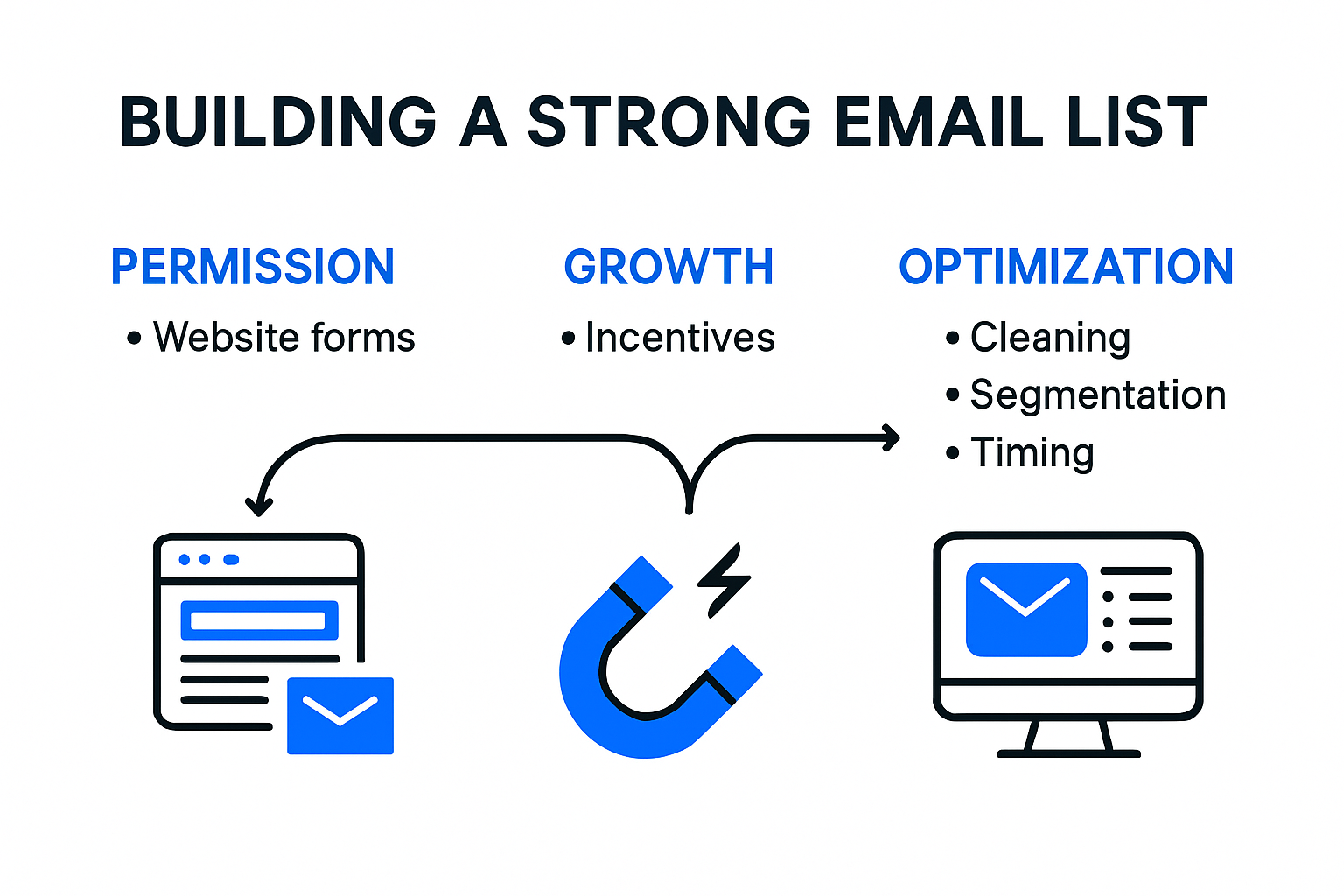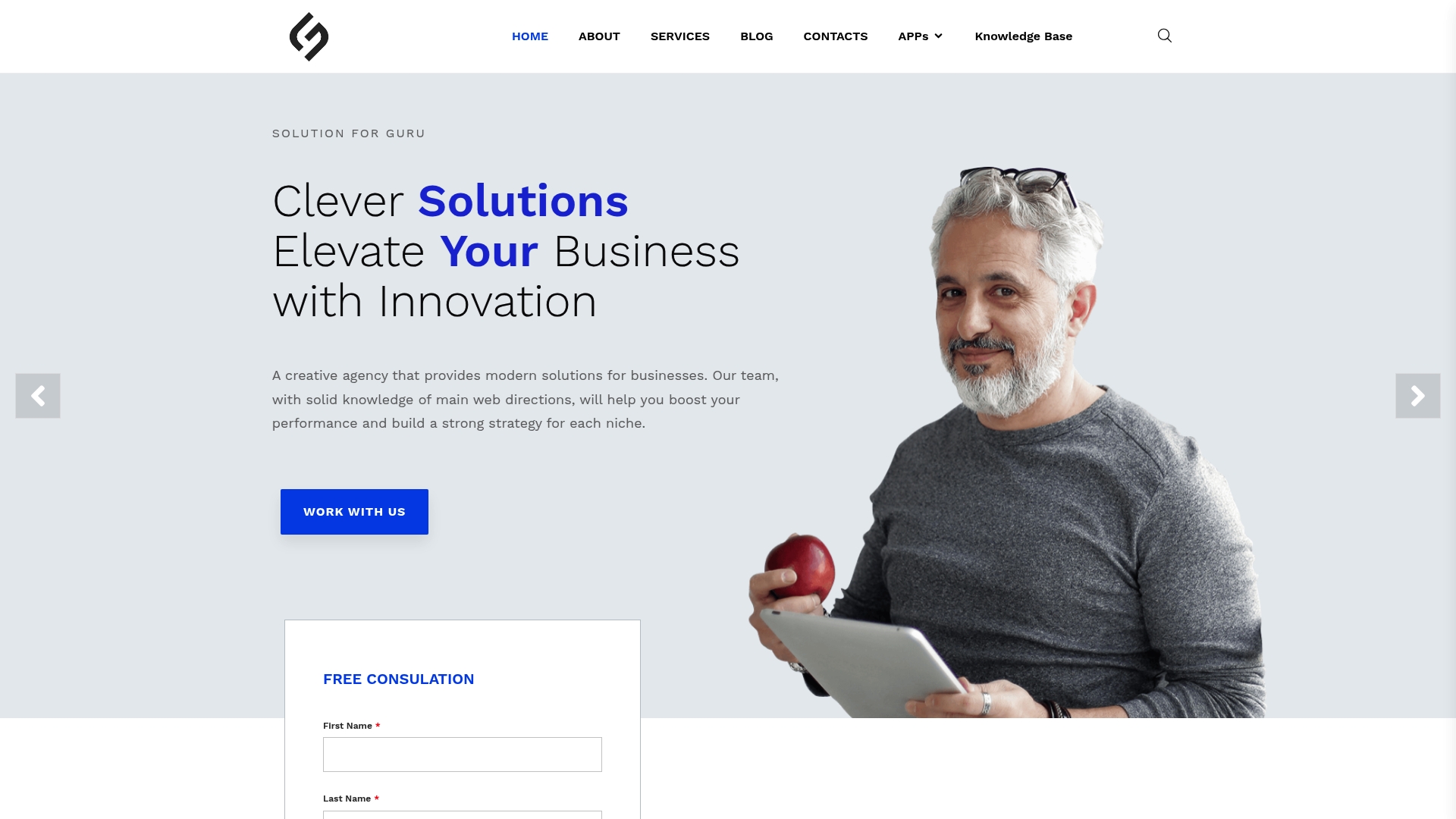Email Marketing Essentials: Grow Your Business with Effective Campaigns

Everyone talks about the power of email marketing for business growth, but what if you learned that email delivers an average return of $42 for every $1 spent? Most people think social media or flashy websites are the future, yet email quietly outperforms them all. The real secret is not about sending more emails but mastering how you build your list, craft your content, and harness automation so every campaign actually lands, engages, and converts.
Table of Contents
- Building A Strong Email List For Growth
- Crafting Compelling Email Content That Converts
- Optimizing Campaigns With Analytics And Automation
- Best Practices For Compliance And Deliverability
Quick Summary
| Takeaway | Explanation |
|---|---|
| Build an engaged email list | Focus on obtaining explicit consent and respecting subscriber preferences for effective email marketing. |
| Craft effective subject lines | Use urgency, personalization, and clear value propositions to increase email open rates. |
| Utilize analytics for optimization | Track open rates, click-through rates, and conversions to refine email marketing strategies. |
| Ensure legal compliance | Follow regulations for transparency and consent to maintain trust and deliverability. |
| Implement automation strategies | Leverage triggers and segmentation to create personalized email experiences for subscribers. |
Building a Strong Email List for Growth
Growing an email list is a critical strategy for businesses seeking to expand their digital marketing reach and drive meaningful customer engagement. While many marketers understand the importance of email marketing, building a quality list requires strategic planning and targeted approaches that respect customer preferences and legal guidelines.
Permission-Based List Building Strategies
Successful email list growth starts with obtaining explicit consent from potential subscribers. The U.S. Small Business Administration emphasizes the critical importance of permission-based marketing, which protects both businesses and consumers. This means creating clear, transparent opt-in mechanisms that give individuals genuine choices about receiving communications.
Effective permission-based strategies include:
Here is a summary table highlighting the key permission-based email list building strategies presented in this section, along with a brief description and examples for each approach:
| Strategy | Description | Example |
|---|---|---|
| Website Sign-Up Forms | Dedicated online forms for voluntary email registration | Newsletter popup on homepage |
| Incentive-Driven Subscriptions | Offering value in exchange for an email address | Free ebook for signing up |
| Social Media Integration | Promoting sign-ups and benefits on social platforms | Instagram bio link to sign-up form |
- Website Sign-Up Forms: Create dedicated spaces on your website where visitors can voluntarily provide their email addresses
- Incentive-Driven Subscriptions: Offer valuable content like exclusive discounts, downloadable resources, or insider information in exchange for email sign-ups
- Social Media Integration: Use social platforms to promote email list sign-ups and highlight the unique value subscribers will receive
Strategic List Growth Techniques
According to the Rhode Island Small Business Development Center, businesses can implement multiple techniques to expand their email lists effectively. One key approach involves creating compelling reasons for potential subscribers to join your list.
Consider developing lead magnets that provide genuine value to your target audience. These might include:
- Comprehensive industry reports
- Free webinars or online workshops
- Exclusive market insights
- Personalized consultation opportunities
The goal is to demonstrate immediate and tangible benefits that make subscribing an attractive proposition for potential customers. By focusing on quality over quantity, businesses can build a robust email list with engaged and interested recipients.
Optimizing Email List Performance
Penn State Extension provides critical insights into maximizing email list effectiveness. Understanding optimal sending times can significantly improve engagement rates. Their research suggests that Sundays and Fridays typically generate higher readership and click-through rates.
Additionally, businesses should:
- Regularly clean and update their email lists
- Segment subscribers based on interests and behaviors
- Monitor engagement metrics
- Provide easy unsubscribe options to maintain list quality
Building a strong email list is not about accumulating the most email addresses but cultivating a community of interested, engaged subscribers who find genuine value in your communications. By implementing strategic, permission-based approaches and continuously refining your list management techniques, you can create a powerful marketing asset that drives business growth and customer loyalty.

Crafting Compelling Email Content That Converts
Email marketing success hinges on creating content that not only captures attention but also drives meaningful action. The art of crafting compelling email content requires a strategic approach that combines psychological insights, clear communication, and targeted messaging.
The Science of Engaging Subject Lines
Research from the Email Subject Line Generation Study reveals that subject lines are the critical first point of engagement for any email communication. These few words determine whether a recipient will open or ignore your message. Effective subject lines should be concise, provocative, and directly communicate the value proposition.
Key strategies for crafting powerful subject lines include:
- Urgency Creation: Use time-sensitive language that prompts immediate action
- Personal Relevance: Incorporate recipient-specific details or personalization
- Clear Value Proposition: Communicate the specific benefit of opening the email
- Curiosity Triggering: Create a subtle knowledge gap that compels readers to learn more
Writing Style and Content Optimization
Linguistic research on communication effectiveness demonstrates that writing style profoundly impacts message reception. The study highlights that simplicity, personal voice, and strategic temporal perspective significantly enhance communication impact. This means transforming complex ideas into clear, conversational language that resonates with your audience.
Practical approaches to content optimization include:
- Simplify Complex Ideas: Break down technical concepts into easily digestible language
- Use Conversational Tone: Write as if speaking directly to the reader
- Focus on Benefits: Emphasize how your message solves specific problems
- Create Narrative Flow: Structure content with a clear beginning, middle, and compelling call to action
Length and Engagement Strategies
Academic research on communication brevity provides fascinating insights into message effectiveness. The study found that optimal content length involves strategic reduction. Specifically, message length reductions between 10% and 20% can significantly improve engagement rates.
Implement these content optimization techniques:
- Ruthless Editing: Remove unnecessary words and complex jargon
- Prioritize Key Information: Place most critical details in the first paragraph
- Use White Space: Create visual breathing room in your email design
- Implement Clear Hierarchy: Use headers, bullet points, and formatting to guide reader attention
Crafting compelling email content is a nuanced process that combines psychological understanding, strategic communication, and precise execution. By focusing on engaging subject lines, optimizing writing style, and maintaining concise yet powerful messaging, businesses can transform email communications from mere notifications into powerful marketing tools that drive real conversions and meaningful customer interactions.
Optimizing Campaigns with Analytics and Automation
Email marketing has evolved from a simple communication tool to a sophisticated strategy driven by data and intelligent automation. The ability to leverage analytics and automation transforms email campaigns from generic broadcasts into precision-targeted, personalized experiences that deliver remarkable business results.
Understanding Email Marketing Analytics
The U.S. Small Business Administration highlights a compelling statistic that underscores the power of email marketing: businesses can generate $42 for every $1 spent, representing an extraordinary 4,200% return on investment. This remarkable potential hinges on understanding and acting upon sophisticated analytics.
Key performance metrics businesses should track include:
To help you quickly understand the essential analytics metrics to monitor in your email campaigns, the table below outlines each metric with its definition and the business outcome it supports:
| Metric | Definition | Business Outcome |
|---|---|---|
| Open Rates | Percentage of recipients who open your emails | Measure subject line effectiveness |
| Click-Through Rates | Recipients who click links inside emails | Assess content and call-to-action engagement |
| Conversion Rates | Recipients taking the desired action | Evaluate campaign ROI and revenue generation |
| Subscriber Growth | Tracking additions to your email list | Gauge successful list-building efforts |
| Churn (Attrition) | Tracking unsubscribes/loss from your list | Monitor subscriber retention and engagement |
- Open Rates: Measure the percentage of recipients who actually open your emails
- Click-Through Rates: Track how many recipients engage with links inside the email
- Conversion Rates: Determine the number of recipients who take the desired action
- Subscriber Growth and Churn: Monitor list expansion and attrition
Strategic Automation Techniques
The University of Oregon’s Email Marketing Course emphasizes that successful automation goes beyond simple scheduling. Advanced automation involves creating intelligent, responsive email journeys that adapt to individual user behaviors and preferences.
Effective automation strategies include:
- Triggered Emails: Send messages based on specific user actions or milestones
- Segmentation: Divide your audience into precise groups for targeted messaging
- Personalization: Customize content based on user data and interaction history
- Behavioral Tracking: Monitor and respond to subscriber engagement patterns
Continuous Optimization Frameworks
Optimization is an ongoing process that requires constant refinement and experimentation. Successful email marketers adopt a data-driven approach that combines systematic testing, careful analysis, and agile adaptation.
Implement these optimization techniques:
- A/B Testing: Experiment with different subject lines, content, and design elements
- Predictive Analytics: Use machine learning to forecast subscriber behavior
- Cross-Channel Integration: Align email strategies with other marketing channels
- Regular Performance Audits: Consistently review and adjust campaign parameters
The intersection of analytics and automation represents the future of email marketing. By transforming raw data into actionable insights and leveraging intelligent automation tools, businesses can create email campaigns that are not just communications but strategic assets driving meaningful engagement and sustainable growth. The key lies in viewing email marketing not as a static broadcast medium, but as a dynamic, responsive ecosystem that adapts and evolves with your audience’s changing needs and preferences.

Best Practices for Compliance and Deliverability
Email marketing success depends not just on crafting compelling content, but on navigating complex legal and technical landscapes that ensure messages reach their intended recipients while maintaining ethical standards. Compliance and deliverability represent critical components of a robust email marketing strategy.
Legal and Regulatory Compliance
The University of Illinois Extension provides comprehensive guidelines for email marketing compliance that businesses must carefully follow. These standards encompass multiple dimensions of responsible communication, focusing on transparency, consent, and clear communication.
Key compliance requirements include:
- Accurate Header Information: Ensure sender details are genuine and verifiable
- Transparent Subject Lines: Align subject lines precisely with email content
- Clear Advertisement Disclosure: Explicitly identify commercial communications
- Physical Contact Information: Include a valid postal address
- Straightforward Opt-Out Mechanisms: Provide simple unsubscribe options
Technical Deliverability Strategies
The Internet Society’s Online Trust Alliance emphasizes the importance of creating unsubscribe processes that are user-friendly and immediately actionable. Effective deliverability requires a multifaceted approach that addresses technical, content, and user experience considerations.
Critical technical deliverability tactics include:
- Authentication Protocols: Implement SPF, DKIM, and DMARC records
- Sender Reputation Management: Monitor and maintain positive sending reputation
- List Hygiene: Regularly clean and update email lists
- Engagement Tracking: Monitor recipient interactions and adjust strategies
- One-Click Unsubscribe: Provide immediate and simple opt-out options
Proactive Email Infrastructure Management
The University of California, Berkeley’s Information Security Office recommends comprehensive strategies for managing email communication infrastructure. This involves not just meeting minimum compliance standards, but establishing robust systems that protect both sender and recipient.
Proactive management strategies include:
- Regular Compliance Audits: Periodically review email practices
- Spam Filter Optimization: Develop content that avoids triggering spam indicators
- Continuous Education: Stay updated on evolving email marketing regulations
- Technology Investment: Utilize advanced email marketing platforms
- Recipient Consent Management: Maintain clear records of subscriber permissions
Comprehensive email marketing compliance is more than a legal requirement. It represents a commitment to building trust, respecting recipient preferences, and maintaining the integrity of digital communication channels. By adopting a holistic approach that balances technical sophistication, legal adherence, and user-centric design, businesses can create email marketing strategies that are not just effective, but fundamentally responsible and sustainable.
Frequently Asked Questions
What are the key strategies for building an effective email list?
To build an effective email list, focus on permission-based strategies such as using website sign-up forms, offering incentives in exchange for email addresses, and promoting your email list on social media.
How can I craft compelling subject lines that increase open rates?
Effective subject lines should be concise and create urgency, incorporate personal relevance, clearly communicate value, and trigger curiosity to encourage recipients to open your emails.
What metrics should I track to optimize my email marketing campaigns?
Key metrics to track include open rates, click-through rates, conversion rates, subscriber growth, and churn rates to evaluate campaign effectiveness and refine strategies.
How can I ensure my email marketing campaigns are compliant with regulations?
To ensure compliance, include accurate sender information, provide clear opt-out mechanisms, disclose commercial intent, and maintain transparency in your communications.
Take Control of Your Email Marketing Results with Solution4Guru
Are you struggling to turn your email list into real business growth? You know how important permission-based strategies, clear messaging, and automation are, but getting all these elements to work together can feel overwhelming. Missed engagement, low open rates, and compliance worries can stall your progress and hold back your business. The right expertise can make the difference between wasted effort and real, measurable results.

Let Solution4Guru help you transform your email marketing approach. Our team specializes in building smart automation, personalized campaigns, and user-centered strategies that match your unique goals. Whether you need help with audience segmentation, analytics, or full-scale digital transformation, we deliver proven solutions that move the needle. Visit Solution4Guru.com now to book your free consultation and discover how our digital marketing experts can craft a winning email strategy for your business today.



